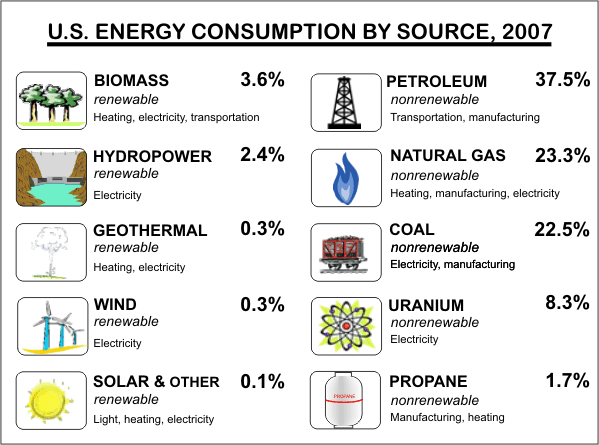Law
of Conservation of Energy
To scientists, conservation of energy
is not saving energy. The law of conservation of energy says
that energy is neither created nor destroyed. When we use energy,
it doesn’t disappear. We change it from one form of energy into
another.
A car engine
burns gasoline, converting the chemical energy in gasoline into
mechanical energy. Solar cells change radiant energy into electrical
energy. Energy changes form, but the total amount of energy
in the universe stays the same. Scientists at the Department
of Energy think they have discovered a mysterious new form of
energy called "dark energy" that is actually causing the universe
to grow!
Energy
Efficiency
Energy efficiency is the amount of useful energy
you get from a system. A perfect, energy-efficient machine would
change all the energy put in it into useful work—an impossible
dream. Converting one form of energy into another form always
involves a loss of usable energy.
In fact,
most energy transformations are not very efficient. The human
body is a good example.
Your body
is like a machine, and the fuel for your machine is food. Food
gives you the energy to move, breathe, and think. But your body
isn’t very efficient at converting food into useful work. Your
body is less than five percent efficient most of the time. The
rest of the energy is lost as heat. You can really feel that
heat when you exercise!
Sources
of Energy
We use many
different energy sources to do work for us. Energy sources are
classified into two groups—renewable
and nonrenewable.
Renewable and nonrenewable energy can be converted into secondary
energy sources like electricity and hydrogen.

In the United States, most of our energy comes from nonrenewable
energy sources. Coal, petroleum, natural gas, propane, and uranium
are nonrenewable energy sources. They are used to make electricity,
to heat our homes, to move our cars, and to manufacture all
kinds of products.
These energy
sources are called nonrenewable because
their supplies are limited. Petroleum, for example, was formed
millions of years ago from the remains of ancient sea plants
and animals. We can’t make more petroleum in a short time.
Renewable
energy sources include biomass, geothermal energy, hydropower,
solar energy, and wind energy. They are called renewable
energy sources because they are replenished in a short time.
Day after day, the sun shines, the wind blows, and the rivers
flow. We use renewable energy sources mainly to make electricity.
Electricity
and hydrogen are different from the other energy sources because
they are secondary
sources of energy. Secondary sources of energy—energy carriers—
are used to store, move, and deliver energy in easily usable
form. We have to use another energy source to make electricity
or hydrogen. In the United States, coal is the number one energy
source for generating electricity. Today the cheapest way to
get hydrogen is by separating it from natural gas, a nonrenewable
energy source. Hydrogen can also be separated from water and
from renewables but hydrogen made from these sources is currently
too expensive to compete with other fuels. Scientists are working
on ways to make hydrogen from water and renewables more affordable.

